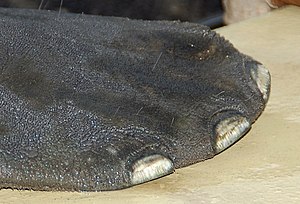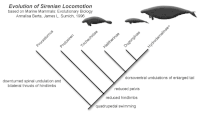
The Sirenia, commonly referred to as sea cows or sirenians, are an order of fully aquatic, herbivorous mammals that inhabit swamps, rivers, estuaries, marine wetlands, and coastal marine waters. The extant Sirenia comprise two distinct families: Dugongidae and Trichechidae with a total of four species. The Protosirenidae and Prorastomidae families are extinct. Sirenians are classified in the clade Paenungulata, alongside the elephants and the hyraxes, and evolved in the Eocene 50 million years ago (mya). The Dugongidae diverged from the Trichechidae in the late Eocene or early Oligocene.
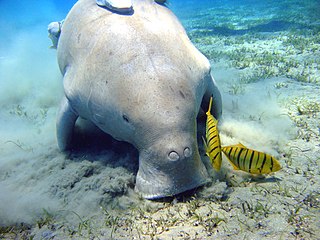
Dugongidae is a family in the order of Sirenia. The family has one surviving species, the dugong, one recently extinct species, Steller's sea cow, and a number of extinct genera known from fossil records.

Marine mammals are mammals that rely on marine (saltwater) ecosystems for their existence. They include animals such as cetaceans, pinnipeds, sirenians, sea otters and polar bears. They are an informal group, unified only by their reliance on marine environments for feeding and survival.

Steller's sea cow is an extinct sirenian described by Georg Wilhelm Steller in 1741. At that time, it was found only around the Commander Islands in the Bering Sea between Alaska and Russia; its range extended across the North Pacific during the Pleistocene epoch, and likely contracted to such an extreme degree due to the glacial cycle. It is possible indigenous populations interacted with the animal before Europeans. Steller first encountered it on Vitus Bering's Great Northern Expedition when the crew became shipwrecked on Bering Island. Much of what is known about its behavior comes from Steller's observations on the island, documented in his posthumous publication On the Beasts of the Sea. Within 27 years of its discovery by Europeans, the slow-moving and easily-caught mammal was hunted into extinction for its meat, fat, and hide.

The Desmostylia are an extinct order of aquatic mammals native to the North Pacific from the early Oligocene (Rupelian) to the late Miocene (Tortonian). Desmostylians are the only known extinct order of marine mammals.

Paenungulata is a clade of "sub-ungulates", which groups three extant mammal orders: Proboscidea, Sirenia, and Hyracoidea (hyraxes). At least two more possible orders are known only as fossils, namely Embrithopoda and Desmostylia.

Hydrodamalis is a genus of extinct herbivorous sirenian marine mammals, and included the Steller's sea cow, the Cuesta sea cow, and the Takikawa sea cow. The fossil genus Dusisiren is regarded as the sister taxon of Hydrodamalis: together, the two genera form the dugong subfamily Hydrodamalinae. They were the largest member of the order Sirenia, whose only extant members are the dugong and the manatees. They reached up to 9 metres (30 ft) in length, making the Steller's sea cow among the largest mammals other than whales to have existed in the Holocene epoch. Steller's sea cow was first described by Georg Wilhelm Steller,
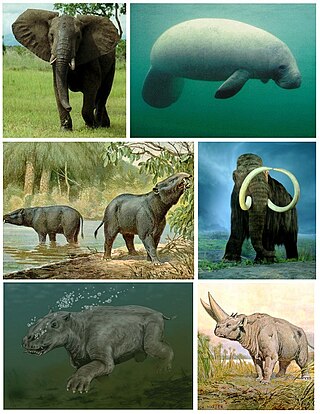
Tethytheria is a clade of mammals that includes the sirenians and proboscideans, as well as the extinct order Embrithopoda.

Halitherium is an extinct dugongid sea cow that arose in the late Eocene, then became extinct during the early Oligocene. Its fossils are common in European shales. Inside its flippers were finger bones that did not stick out. Halitherium also had the remnants of back legs, which did not show externally. However, it did have a basic femur, joined to a reduced pelvis. Halitherium also had elongated ribs, presumably to increase lung capacity to provide fine control of buoyancy. A 2014 review presented the opinion that the genus is dubious.

Pezosiren portelli, also known as the "walking manatee", is a basal sirenian from the early Eocene of Jamaica, 50 million years ago. The type specimen is represented by a Jamaican fossil skeleton, described in 2001 by Daryl Domning, a marine mammal paleontologist at Howard University in Washington, DC. It is believed to have had a hippopotamus-like amphibious lifestyle, and is considered a transitional form between land and sea mammals.
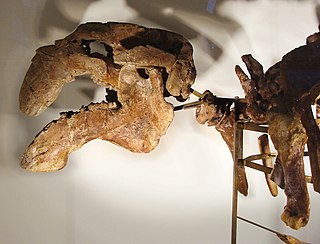
Eotheroides is an extinct genus of Eocene sirenian. It is an early member of the family Dugongidae, which includes the extant dugong. Fossils have been found from Egypt, India, and Madagascar. Eotheroides was first described by Richard Owen in 1875 under the name Eotherium, which was replaced by the current name in 1899.
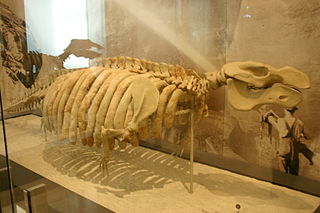
Metaxytherium is an extinct genus of dugong that lived from the Oligocene until the end of the Pliocene. Fossil remains have been found in Africa, Europe, North America and South America. Generally marine seagrass specialists, they inhabited the warm and shallow waters of the Paratethys, Mediterranean, Caribbean Sea and Pacific coastline. American species of Metaxytherium are considered to be ancestral to the North Pacific family Hydrodamalinae, which includes the giant Steller's sea cow.
Protosiren is an extinct early genus of the order Sirenia. Protosiren existed throughout the Lutetian to Priabonian stages of the Middle Eocene. Fossils have been found in the far-flung locations like the United States, Africa (Egypt), Europe and Asia.

Nanosiren garciae is an extinct sirenian dugong that lived in warm shallow seas in what is now Venezuela, approximately 11.610—3.6 Ma during the Miocene and Pliocene. The species is listed in the Paleobiology Database, funded by the Australian Research Council.
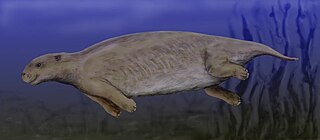
Prorastomidae is a family of extinct sirenians from Jamaica, related to the extant manatees and dugong. The family includes the oldest known fossils of Sirenians, represented in two genera:
Protosirenidae is an extinct primitive family of the order Sirenia.

Altungulata or Pantomesaxonia is an invalid clade (mirorder) of ungulate mammals comprising the perissodactyls, hyracoids, and tethytheres.

The Cuesta sea cow is an extinct herbivorous marine mammal and is the direct ancestor of the Steller's sea cow. They reached up to 9 metres (30 ft) in length, making them among the biggest sirenians to have ever lived. They were first described in 1978 by Daryl Domning when fossils in California were unearthed. Its appearance and behavior are largely based on that of the well-documented Steller's sea cow, which, unlike the Cuesta sea cow, lived into modern times and was well-described.

Lentiarenium was an early sea cow from the Late Oligocene (Chattian) Linz-Melk Formation of Austria. Known since the mid 19th century, Lentiarenium was long considered to be a species of Halitherium until a 2016 analysis showed it to be distinct.
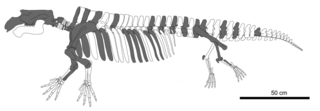
Sobrarbesiren is a genus of extinct sirenian that lived in the Eocene, about 47 million years ago. The type and only species is S. cardieli, known from a multitude of specimens from the Spanish Pyrenees. Sobrarbesiren was a medium-sized animal, 2.7 m long and still retaining both pairs of limbs. Although initially thought to be amphibious, later studies instead suggest that they would have been fully aquatic and been selective sea grass browsers. Unlike modern dugongs and manatees, they likely lacked a tail fluke, although it would have appeared horizontally flattened.
